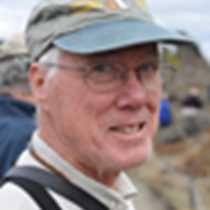Cuverville Island, and then South
During the evening the National Geographic Endeavour crossed the Bransfield Straits to reach the west side of the Antarctic Peninsula, and then continued to the south. The west side is the snowy side of the Antarctic Peninsula. The mountains of the Peninsula and its flanking islands intercept winds from the open Bellinghausen Sea, bringing an accumulation of snow. This is compressed into ice to form the myriad glaciers that flow down the mountainsides, eventually reaching the sea to become the icebergs that fill these waters. We turned into the Errera Channel, between the Arktowski Peninsula of the Antarctic Continent and Rongé Island, for our morning destination of Cuverville Island. It is home to a breeding colony of Gentoo penguins. After the noise and raucous behavior of chinstrap penguins yesterday at Baily Head, this was a scene of relative tranquility – adult penguins sitting on well-formed nests of stone with only occasional neighborly squabbles. From time to time a bird would rise up to reveal the two small gray chicks that it was protecting from the Antarctic cold. Most nests were attended by one adult, male or female, while the mate was away gathering food for the growing young. We watched the exchange that occurs when an adult returns from a feeding sojourn at sea, greets its mate with a vocal exchange, and the two then switch positions – feeder becomes protector and the erstwhile protector departs to feed. Predatory skuas flew low over the colony, watching for a moment when they might swoop in and snatch a poorly protected chick. And so it goes, back and forth, as penguins and skuas each seek to raise their young in the short Antarctic summer.
We spent the rest of our day cruising south through breathtaking Antarctic scenery, glaciers flowing down near-vertical slopes all around us. We made a visit to Paradise (Harbor) where we stopped the ship to count the blue-eyed shags (an Antarctic cormorant) nesting on a vertical cliff near an abandoned Argentine research Station. In the late afternoon (if I can use that term where the sun is up almost around the clock) we entered the narrow Lemaire Channel, between the Antarctic Continent and Booth Island. Its northern entrance is marked by two magnificent, symmetrical, snow-tipped stacks that commemorate the fair Oona in Antarctic lore.
And on we went, ever southward, expecting to cross the Antarctic Circle in the early morning hours.
During the evening the National Geographic Endeavour crossed the Bransfield Straits to reach the west side of the Antarctic Peninsula, and then continued to the south. The west side is the snowy side of the Antarctic Peninsula. The mountains of the Peninsula and its flanking islands intercept winds from the open Bellinghausen Sea, bringing an accumulation of snow. This is compressed into ice to form the myriad glaciers that flow down the mountainsides, eventually reaching the sea to become the icebergs that fill these waters. We turned into the Errera Channel, between the Arktowski Peninsula of the Antarctic Continent and Rongé Island, for our morning destination of Cuverville Island. It is home to a breeding colony of Gentoo penguins. After the noise and raucous behavior of chinstrap penguins yesterday at Baily Head, this was a scene of relative tranquility – adult penguins sitting on well-formed nests of stone with only occasional neighborly squabbles. From time to time a bird would rise up to reveal the two small gray chicks that it was protecting from the Antarctic cold. Most nests were attended by one adult, male or female, while the mate was away gathering food for the growing young. We watched the exchange that occurs when an adult returns from a feeding sojourn at sea, greets its mate with a vocal exchange, and the two then switch positions – feeder becomes protector and the erstwhile protector departs to feed. Predatory skuas flew low over the colony, watching for a moment when they might swoop in and snatch a poorly protected chick. And so it goes, back and forth, as penguins and skuas each seek to raise their young in the short Antarctic summer.
We spent the rest of our day cruising south through breathtaking Antarctic scenery, glaciers flowing down near-vertical slopes all around us. We made a visit to Paradise (Harbor) where we stopped the ship to count the blue-eyed shags (an Antarctic cormorant) nesting on a vertical cliff near an abandoned Argentine research Station. In the late afternoon (if I can use that term where the sun is up almost around the clock) we entered the narrow Lemaire Channel, between the Antarctic Continent and Booth Island. Its northern entrance is marked by two magnificent, symmetrical, snow-tipped stacks that commemorate the fair Oona in Antarctic lore.
And on we went, ever southward, expecting to cross the Antarctic Circle in the early morning hours.


